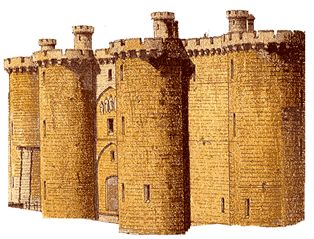The Bastille was built to defend against dangerous... scholars. One 18th century work says the Bastille was built (in 1369) by Hughes Aubriot, the Paris Provost, to protect townsfolk from marauding students.
When visting Paris, one sight to see was… the collection of old weapons at the Bastille. This was housed in a museum in the first gate house, so visitors were still a good way from the big grim castle.
A good place to watch fireworks was... the Bastille. Visitors could watch them from the towers (while those pesky prisoners were carefully locked out of sight.)
To stay in shape in the Bastille, how about... a good whipping? Renneville arrived in a new 'apartment' and found (he claims) one of his two new roommates whipping the other. When he tried to interfere, the whippee (an old man) stopped him, saying this was a great way to keep up his strength.
"Le service n'est pas compris!" (the tip's not included). Well-off prisoners were expected to 'gratify' the turn-keys when they left. One turn-key, a generally amiable man, was very put out when a departing prisoner only gave him three louis. "A reasonable person gives at least thirty," he grumbled.
Sometimes, even "Enlightened" thinkers thought the Bastille was... a good thing. Writers for the Correspondance Littéraire were less than devastated when the journalist Linguet was arrested. Voltaire and friends probably played a part in events which led to the arrest of the writer La Beaumelle..... Etc. (Those literary quarrels could get MEAN.)
Some people actually liked it there. Madame de Staal not only found it a welcome relief from her servitude to the demanding Duchess of Maine, but managed to carry on a passionate love affair (and to get propositioned more than once) while a prisoner. Dumouriez, Morellet and Marmontel all took their stays in good part. One man took refuge there from his creditors. Pelliseri, a more obscure prisoner, supposedly refused to leave when invited to do so, but he was apparently being contrary - and wasn't quite stable overall.
No walk-ins, please. One man showed up and tried to turn himself in, but was told the governor needed a lettre de cachet before accepting him as a prisoner.
Arrests could be very cordial. Marmontel, having admitted to the minister Choiseul that he'd written what he was accused of, was told - kindly, but firmly - that he'd have to go to the Bastille. Having gone on to another minister to get things rolling, he asked (I paraphrase), "OK if I go out to dinner first?" "But of course.". He then had a heck of a time turning himself in, and had to wait until the following day.
It had its defenders. The writer Lescure, in his notes to the Correspondance Secrète, calls it 'benign', and has only contempt for those who said such nasty things about it. Others attacked Linguet's famous Memoirs of the Bastille (though probably because they hated the irrascible Linguet more than they did the Bastille.)
From warden to prisoner... François, Marquis of Bassompierre (1579-1646) was governor - that is, warden - of the prison for about 10 days in 1617. In 1631, he was arrested and spent twelve years as a prisoner.
Born at the Bastille, died defending it... Bernard René Jourdan, Marquis de Launay (1740-1789), the last governor of the Bastille, was himself the son of a governor and was born there. If he didn't quite die there, it's only because the crowd was taking him to the Hotel de Ville when they killed him.
The people who stormed it were really small - on average, about five feet high, weighing one hundred pounds. As the economist Robert Fogel put it: "They didn't look like Errol Flynn and Alan Hale. They looked like thirteen-year-old girls." Which is more of a comment on the decline in French stature since Charlemagne (who had been over six feet tall) than it is on that particular group.
The British Bastille? Some might say this is the Tower of London. But in fact, from 1420 or earlier, until 1436, the Bastille was in English hands - starting with:
Falstaff, captain of the Bastille - Shakespeare's famous character may have originally been based on someone with a completely different name (Oldcastle). But his name and some details of his story seem to come from a Sir John Fastolf (1378?–1459) who served in France from at least 1413 to 1440 (and who was, like Falstaff, accused of cowardice - though probably unfairly). In 1421 (possubly 1420), Henri V appointed this man as its captain (the title used before 'governor') for a year. (Those who want to celebrate his tenure can have a beer at the Falstaff-Bastille, 10 Place de la Bastille, the next time they're in Paris.)

 or mug:
or mug: ?
? 